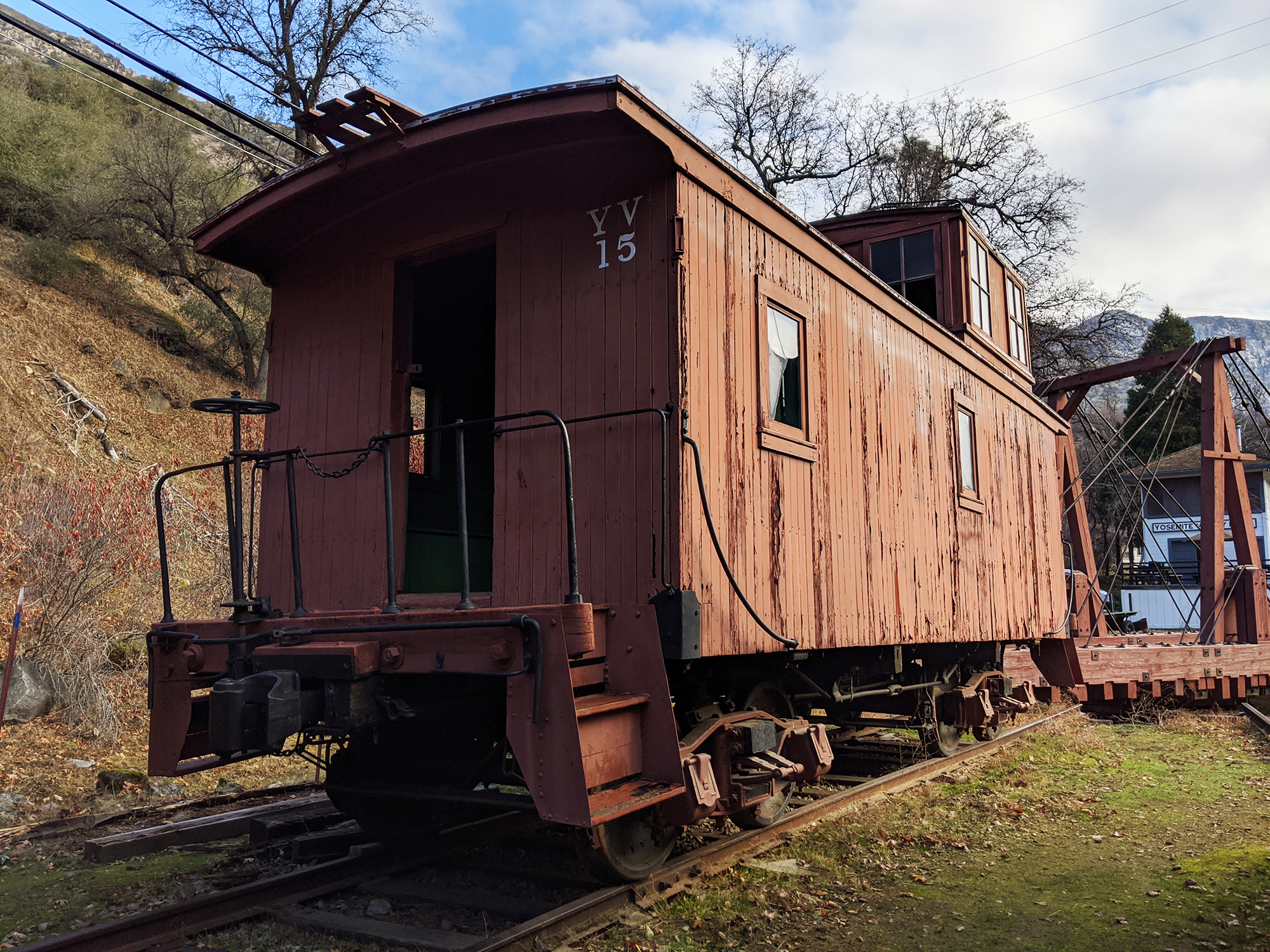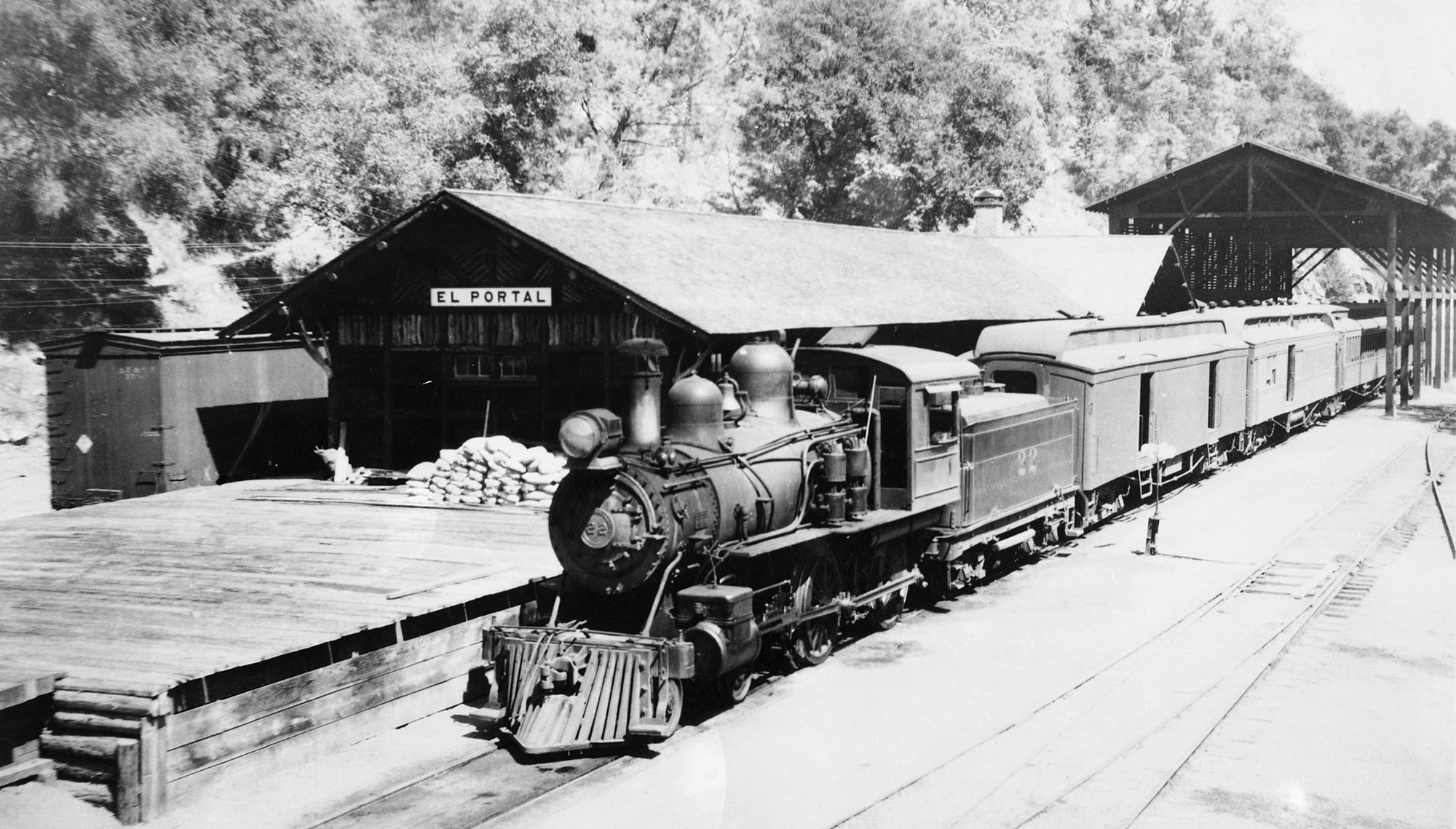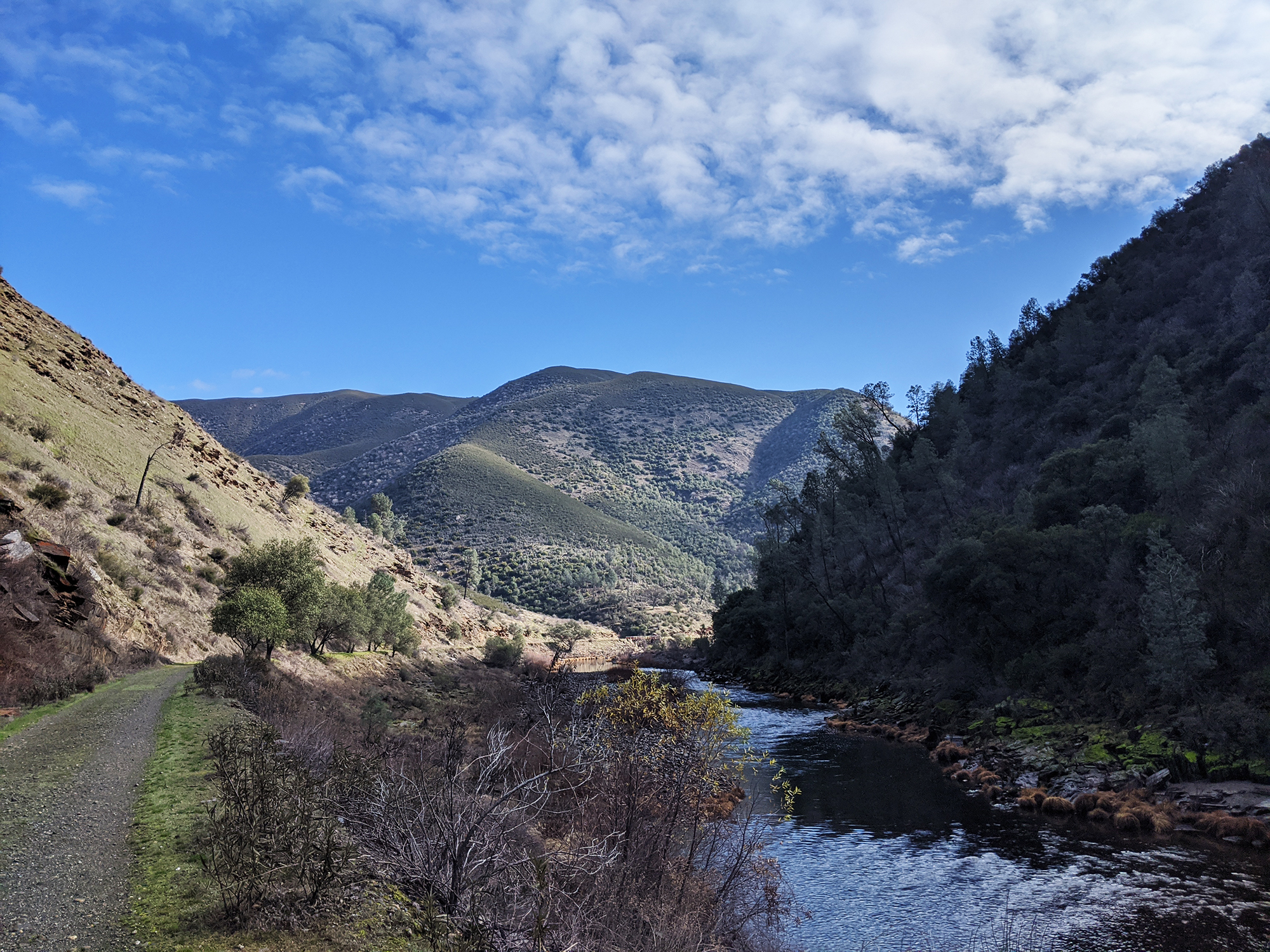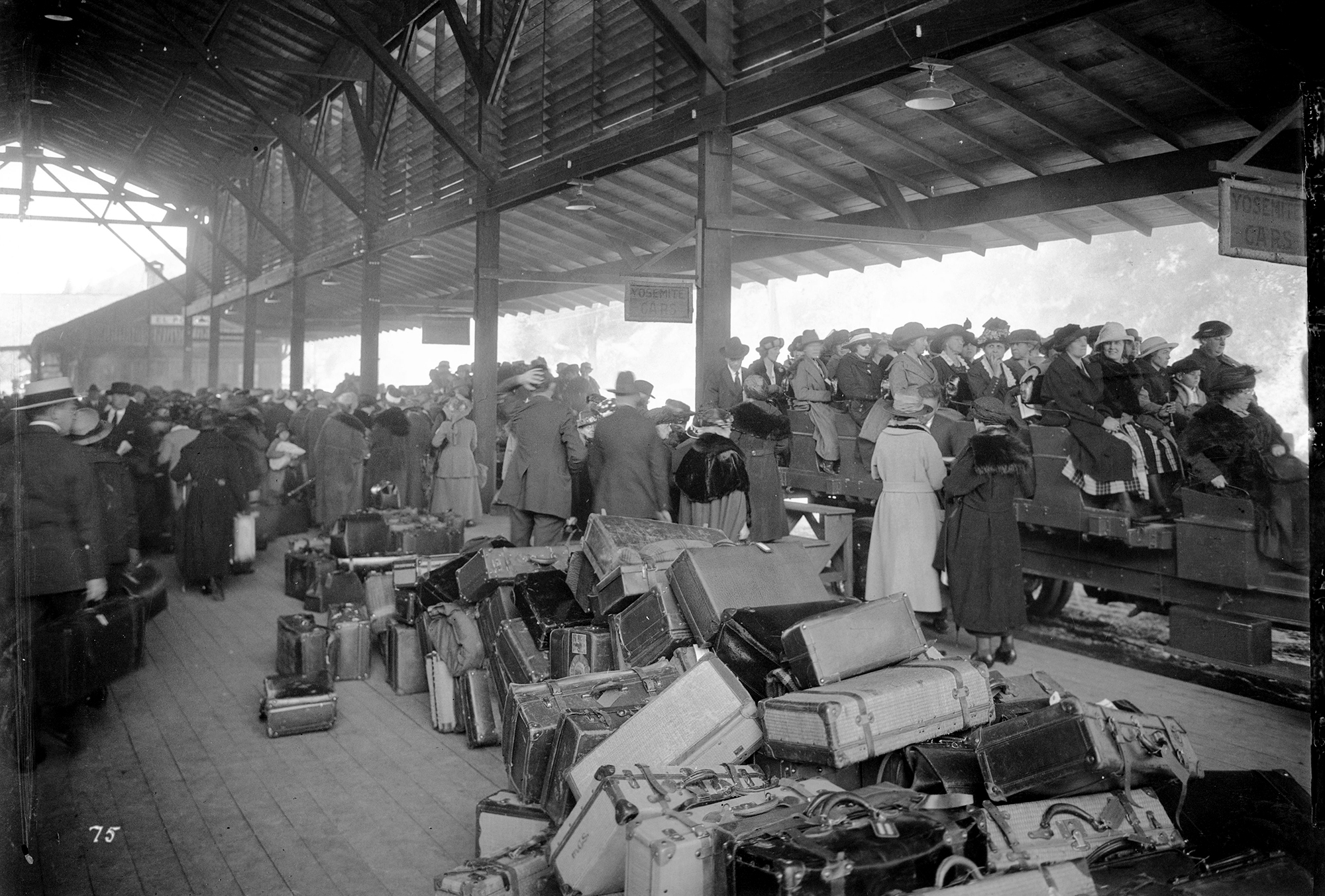
“So this was one of the actual Yosemite cabooses? Wait, cabooses? Cabeese?”
We cautiously climb down the iron rungs from the cupola, the windowed loft in the center of the caboose, where the train crew would have sat in elevated seats to keep watch on the cars ahead. Luckily Matt knows all the proper train terminology, which he eagerly shares with me as we explore the locomotive and caboose retired at El Portal.
Matt and I became friends over the summer while working as seasonal rangers in Glacier Bay National Park, and we both made our way to Yosemite for the winter as volunteer interns. When I told him I was researching the Yosemite Valley Railroad, he suggested we explore the Merced River canyon just outside the park, the route of the old shortline.
It’s a bright Saturday morning, and the foothills begin to glow as we cruise west down Highway 140, away from Yosemite and El Portal. This is the “All-Year Highway” to the park, originally completed in 1926, that spelled the beginning of the end for the Yosemite Valley Railroad.
The Yosemite Valley Railroad began service in 1907, at a time when getting to Yosemite was a long and uncomfortable journey. Visitors spent two days or more bumping along dusty wagon roads in a horse-drawn stage to reach Yosemite Valley. The only routes into the park wound high through the mountains, impassable once snow began to fall. While most early visitors found the arduous journey worthwhile, a few California businessmen envisioned a much more convenient way to get to the park: a three-and-a-half-hour journey by rail up the Merced River Canyon from Merced to El Portal, just outside what is now Yosemite’s Arch Rock Entrance. Today, the gas station in El Portal stands on the site of the old train depot, where passengers hopped off the train and onto waiting horse-drawn stages, later switched to automobiles.

Construction and the purchase of equipment began in 1905, costing somewhere between $3 and $4 million. For the first time in May of 1907, park visitors could board a train in the city of Merced and make the 78-mile journey to Yosemite in relative comfort. In later years, the YVRR made arrangements with the Southern Pacific and Santa Fe Railroads to provide through service to Yosemite from San Francisco and Los Angeles. Yosemite visitors could depart the city in the afternoon or evening, spend the night in a Pullman sleeper car, and wake up to find their car transferred from the main line to a Yosemite Valley steam locomotive. Passengers enjoyed breakfast in the dining car as the train puffed up gentle hills and over wooden trestles, following the scenic Merced River north and then east to Yosemite.
It was not unusual for dignitaries and the wealthy to visit Yosemite by rail, often in their own private cars. Even President Franklin D. Roosevelt travelled the Yosemite Valley Railroad. In 1938, he crossed the country by rail on a campaign tour. When the Yosemite Valley Railroad picked up the president’s party from the Southern Pacific in Merced, three freshly-painted, decorated locomotives pulled the ten cars, including the president’s private car, to El Portal. Roosevelt and his entourage were driven to the Mariposa Grove for lunch, and they were on their way back to Merced by evening.
We follow the trains’ route in reverse. Across the river from the highway, the narrow roadbed is visible, the tracks now long-gone. Just west of El Portal, it’s a paved one-lane road leading to a campground and a handful of homes. In the hefty reference volume I have with me, Trains to Yosemite, this is marked on the map as Incline. Here, another track climbed 3,000 feet into the mountains, an extremely steep grade used to bring loaded log cars down to the Yosemite Valley Railroad, where they could be delivered to a lumber mill down the line.
In another mile-and-a-half, we pass the site of an old gold mine. Six miles further downriver is the site of an old limestone quarry. The Yosemite Valley Railroad carried freight for many businesses like these along its line.
It’s 17 miles from El Portal to Briceburg. Here the old railroad and the highway diverge. The highway heads south toward Mariposa, while the train would have continued chugging down the river canyon toward the town of Bagby. While most of the roadbed is almost completely deteriorated, the town of Bagby and part of the old line between it and Merced are now beneath the surface of Lake McClure, a reservoir expanded to its current size in the 1960s.
We make a sharp turn off the highway at Briceburg and cross a narrow suspension bridge. Here we continue along the railbed itself, which winds along a narrow ledge, a steep hill to our right and a sheer drop-off to the Merced River on our left. After a few miles, the road turns into a hiking trail, so we grab our backpacks and the hefty Trains to Yosemite and continue on foot.
We walk along the flat, grassy path where tracks once ran. A mile in, our route narrows, and the trail is now littered with so much rockfall, I can’t imagine how a train could have travelled this route. We hear an American dipper chattering loudly from the river. As we stop to take a look, we notice something in the water.
“Is that a rail?” Matt wonders aloud. He scampers down the rocky slope to the river to get a better look. I stay on the trail and open Trains to Yosemite, inspecting the map. We’re in the vicinity of the Mountain King Mine, which had its gold and silver heyday in the 1910s. A black-and-white photo shows a busy operation, with at least a dozen buildings and a spur track that climbed steeply up to the stamp mills where ore was processed. On our way back, we’ll find this exact location, all of the structures now gone.

“It’s definitely a rail!” Matt calls excitedly from the river. A flood must have swept the rail into the river, one of the only remnants of the old track still left.
The morning sun creeps through the narrow river canyon as we walk back, layers of green hills and tall mountain peaks glowing east of us.
I imagine the tracks laid out along the river. Time rolls back nearly 100 years, and a steam locomotive puffs past us, heading east toward Yosemite, its whistle echoing through the canyon. Behind the engine and its tender, there is a combine car, carrying mail, baggage, and passengers, then a string of coaches and Pullman sleeper cars, a dining car, and the open-ended observation car bringing up the rear. The train will pull into the station at El Portal in less than an hour, and the passengers onboard are enjoying breakfast and coffee. The weather is nice, and first-class passengers lounge in folding chairs on the back deck of the observation car, enjoying the view. Perhaps many of the train’s passengers are visiting Yosemite for the first time, imagining what wonders await them. In El Portal, auto stages will pick them up from the station and deliver them to Yosemite Valley, on the road constructed by the railroad.

In 1926, the “All-Year Highway,” now Highway 140, was opened. For the first time, the drive to Yosemite was relatively easy all year, running along the opposite side of the river from the railroad, at low elevation with comfortably wide turns. Motorists flocked to the park, and regular bus service began from Merced, at a much lower fare than the train.
The Yosemite Valley Railroad, which was already struggling financially, saw its passenger revenue drop 38% in the year following the opening of the highway. The railroad hung on thanks to the freight service it provided, but as mining and lumber operations gradually folded along the line, things worsened. By 1945, the railroad was bust, and it was sold off for scrap. Tracks were quickly removed from the line. While some pieces of equipment were sold to other railroads, many of the aging locomotives and cars were scrapped.
Over its lifespan, the Yosemite Valley Railroad owned ten steam locomotives. All were eventually scrapped except for Number 29, which was sold to a railway in Mexico, where it is now retired and on display. One observation car, YV330, is in private hands and is being lovingly restored by its owner. In El Portal, Caboose 15 is on display, along with a locomotive from the Hetch Hetchy Railroad, the old turntable, and the old Bagby station, relocated before the town was flooded. The old El Portal station burned down not long after the railroad stopped running.
Not much else from the Yosemite Valley Railroad survives, just an empty, crumbling roadbed across from the highway and a lonely rail washed into the Merced River.
